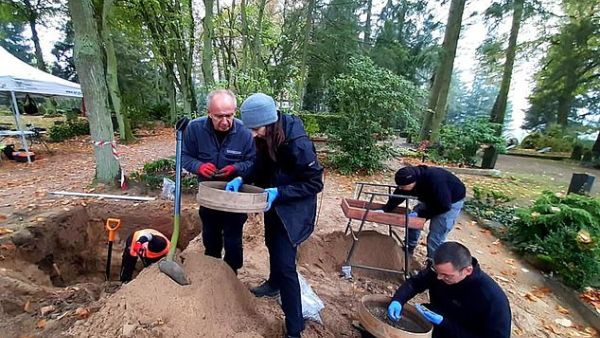Remains of Polish women killed in the all-female Ravensbruck concentration camp have been discovered at a nearby cemetery in northern Germany.
A team from Poland's Institute of National Remembrance, which was set up to investigate Germany's WWII-era crimes, made the discovery of their remains in urns at the Furstenberg cemetery.
Nine urns and two metal plaques were uncovered at the cemetery. It is believed they contain the remains of Polish women who had been killed at a site near Ravensbruck village, which had served as the base for a German concentration camp in 1939 to 1945.
The urns had broken down in the soil but the two metal plaques remained in a relatively good condition and containing the names of the female relatives of the post-war bishop of Wroclawek - Bronisław Dembowski.
His sister and mother, Henryka and Małgorzata Dembowska, were named on the two metal plaques, alongside their place and date of birth, and place and date of death.
Bishop Dembowski worked in a Catholic organisation during the early 1980s when Poland was under martial law.
{"preview_thumbnail":"https://cdn.flowplayer.com/6684a05f-6468-4ecd-87d5-a748773282a3/i/v-i-e…","video_id":"e28516d2-be17-4d9a-aa1a-16e49deb8ab7","player_id":"8ca46225-42a2-4245-9c20-7850ae937431","provider":"flowplayer","video":"Lebanese Protestors Barricade Roads, Press Demands for Hariri Resignation"}
He was known for helping those activists who pushed back against the then-government's authoritarian rule. In 1989, he also represented the Catholic Church at the Round Table negotiations between the government and the opposing parties.
The Ravensbruck camp, where his relatives have just been found, was the largest concentration camp for women.
Opened in March 1939, 56 miles north of Berlin, it was exclusively for women - the majority of whom were Polish women, alongside Jewish, Russian, French and Dutch prisoners.
The female prisoners were regularly exposed to medical experiments and sterilisation as well as torture.
Out of the 130,000 women at the camp close to 40,000 were from Poland. Only 8,000 survived.
The camp didn't have its own burial site for victims, so it used the cemetery in nearby Fürstenberg in north-east Germany.
Women who died at the camp were cremated and their ashes were placed in urns before being buried.
In 1989, a mass grave was discovered at the cemetery, and a panel commemorating the victims was created at a local museum.
However, Polish media outlet The First News said many of the names were reportedly misspelled and the victims were not informed of the discovery.
This led to the polish-led archaeological dig of the site to further identify the women who may have been buried at the cemetery in Germany.
Krzysztof Szwagrzyk, from Poland's Institute of National Remembrance, told local media next spring a ceremony will take place and the women will be buried properly.
'We are planning a funeral ceremony here, as well as the unveiling of a monument to be erected by the Institute of National Remembrance,' he said.
'The monument will bear the names and surnames of the victims, as well as their faces, because our aim is to restore the memory of the victims of totalitarianism, including German Nazism.'
This article has been adapted from its original source.








